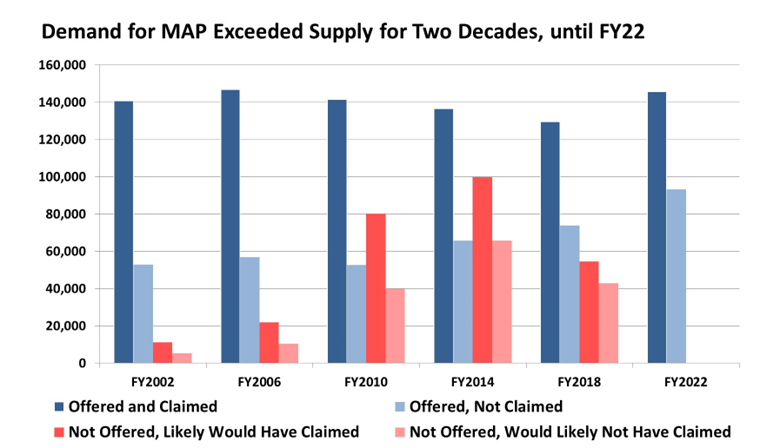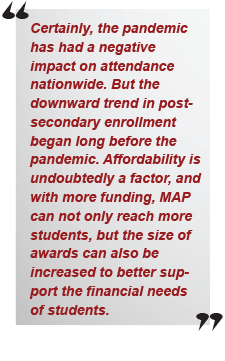- MAP Matters

- About MAP

- Why MAP Matters
Why MAP Matters
MAP grants help make college possible for more than 145,000 Illinoisans annually. That matters a lot because by 2027, 70 percent of jobs will require a college credential.1
By 2026, the number of jobs requiring a bachelor’s degree is expected to be 10 percent higher than it was in 2016, with 17 percent more jobs requiring a master’s degree and 13 percent more requiring a doctoral or professional degree than a decade earlier. Conversely, the growth rate for occupations not requiring postsecondary education will be slower than overall occupational growth. According to the Bureau of Labor Statistics’ list of the 30 fastest-growing occupations, 18 of those require more than a high school diploma.2 Yet currently about 57% of working-age adults (25- 64) in Illinois hold a two or four year college degree or high quality postsecondary certificate.3
College enrollment for students in the top income quartile is 79% nationally, compared to 48% for those in the lowest income quartile. The gap in bachelor degree attainment (by age 24) is even wider: For those students in the lowest income quartile it is 15%, compared to 59% for students in the highest income quartile.4 Substantial gaps in postsecondary attainment for adults (age 25-64) in Illinois exist by race/ethnicity as well: Asian American and Pacific Islander at 74.5%; White at 54.3%, American Indian or Alaska native at 25.3%, Black at 33.6%, and; Hispanic at 25.8%.5
More education not only leads to better and more diverse career prospects, financial stability and independence, but it has also been linked to longer life expectancy, better physical and mental health, lower incarceration rates, greater tolerance, higher voter turnout, and better prospects for the next generation.6 So by helping to give individuals the opportunities a college education can bring, MAP is an investment in our communities and in the future of our State.
“The average tuition at Illinois public four-year colleges, adjusted for inflation, increased 18% between 2008 and 2019.7 In the 2021-22 school year, MAP served almost 146,000 students. For the first time in more than two decades, grants were offered to every eligible student.8 In the 2021-22 school year, the maximum MAP award covered 33% of average tuition and mandatory fees at public universities and 38% at community colleges. It is estimated that for the 2022-23 school year, the maximum MAP grant will cover 44% of average tuition and mandatory fees at public universities, and 55% at community colleges.

Note: ISAC calculates the number of students who would likely have accepted the award, had they been offered it, based on the previous year’s data on awards offered and awards accepted (claimed) by college sector.
In FY 22, a MAP grant was offered to every eligible student, and this will almost certainly be true in FY 23. This is good and bad news: It is the combined result of more funding and the unfortunate fact that fewer students are choosing to attend college.
Certainly, the pandemic has had a negative impact on attendance nationwide. But the downward trend in postsecondary enrollment began long before the pandemic. Affordability is undoubtedly a factor, and with more funding, MAP can not only reach more students, but the size of awards can also be increased to better support the financial needs of students. Helping to address affordability will also help students and the State leverage federal Pell dollars. Even with an increase in the size of MAP awards, many students with financial need will need the combination of federal Pell Grant dollars and MAP to afford college. The combined funding must be enough to make college affordable. With a potentially significant increase in MAP funding, the State can make important strides in improving affordability.
MAP Matters – to today’s students, Illinois, and to future generations. Let’s continue to work to make more MAP dollars available to students next fiscal year and beyond.
[1] Anthony Carnevale (founder and director of the Georgetown University Center on Education and the Workforce), Ignore the Hype, College is Worth it, Inside Higher Ed, February 23, 2020. https://www.insidehighered.com/views/2020/02/13/why-one-should-ignore-reports-and-commentary-question-value-college-degree-opinion
[2] A Greater Number of Jobs Require More Education, Leaving Middle-Skill Workers with Fewer Opportunities, University of Virginia Weldon Cooper Center for Public Service Stat Chat, May 10, 2019, http://statchatva. org/2019/05/10/a-greater-number-of-jobs-require-more-education-leaving-middle-skill-workers-with-fewer-opportunities/
[3] A Stronger Nation: Learning Beyond High School Builds American Talent, Illinois Report, Lumina Foundation, 2023, https://www.luminafoundation.org/stronger-nation/report/#/progress/state/IL
[4] See http://pellinstitute.org/downloads/publications-Indicators_of_Higher_Education_Equity_in_the_US_2022_Historical_Trend_Report.pdf (Equity Indicator 1A and 5A).
[5] A Stronger Nation: Learning Beyond High School Builds American Talent, Illinois Report, Lumina Foundation, 2023
[6] Goals for the Common Good: Exploring the Impact of Education, Measure of America and United Way, 2016, http://ssrc-static.s3.amazonaws.com/moa/CGF_FINAL.pdf
[7] Jackson and Saenz, States Can Choose Better Path for Higher Education Funding in COVID-19 Recession, Center on Budget and Policy Priorities, February 17, 2021, https://www.cbpp.org/research/state-budget-and-tax/states-can-choose-better-path-for-higher-education-funding-in-covid
[8] Note that most MAP recipients also receive federal Pell grants, and Pell plus a MAP grant typically covers the current cost of tuition and mandatory fees at community colleges in Illinois.


 College Illinois!®
College Illinois!®


